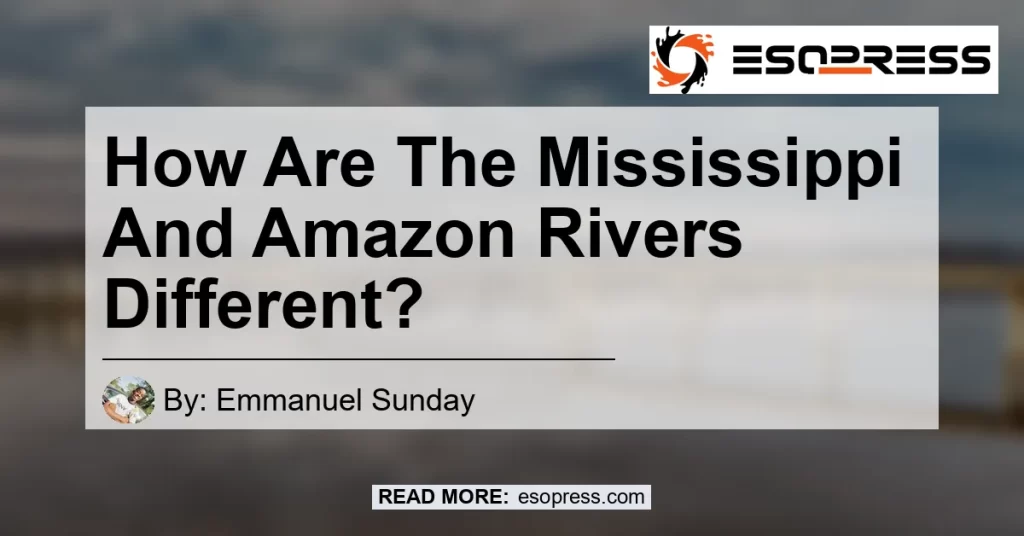

The Mississippi River and the Amazon River are two of the largest and most iconic rivers in the world. While they both hold significant importance in terms of geography and ecosystems, there are several key differences between them.
In this article, we will explore and compare the Mississippi and Amazon rivers, highlighting their unique characteristics and the impacts they have on the surrounding regions.
Contents
- 1 Geography and Surrounding Environment
- 2 Length and Volume
- 3 Cultural and Historical Significance
- 4 Conclusion
- 5 Frequently Asked Questions
- 5.1 What is the difference between the Amazon River and the Mississippi river?
- 5.2 How do the Mississippi and Amazon rivers differ?
- 5.3 Distinguish between Mississippi river and Amazon river.
- 5.4 How much more water does the Amazon River carry than the Mississippi river?
- 5.5 How does the Mississippi River basin compare with the Amazon River basin?
Geography and Surrounding Environment
The first major difference between the Mississippi and Amazon rivers lies in their geographic locations and surrounding environments. The Amazon River is primarily situated in South America and is surrounded by the vast Amazon rainforest, which is considered the largest tropical rainforest in the world.
This dense forest provides a lush and diverse ecosystem, home to countless species of plants and animals.
On the other hand, the Mississippi River flows through the United States and is surrounded by a temperate climate. The region through which it flows experiences four distinct seasons, with deciduous forests and grasslands being predominant.
While the Mississippi River also supports a variety of wildlife, its surrounding environment is quite different from the tropical rainforest of the Amazon.
Length and Volume
Another significant difference between the Mississippi and Amazon rivers is their length and volume. The Amazon River is well-known for being the largest river in terms of both length and volume.
It spans a distance of approximately 6,400 kilometers (4,000 miles) from its source in the Andes Mountains to its mouth in the Atlantic Ocean. In terms of volume, the Amazon discharges approximately 7,400,000 cubic feet per second, making it the largest river by volume in the world.
In comparison, the Mississippi River, while still an impressive river, is considerably shorter in length and has a lower volume. The Mississippi River spans about 3,730 kilometers (2,320 miles) from its source in Minnesota to its mouth in the Gulf of Mexico.
Its volume, at approximately 593,000 cubic feet per second, is significantly less than that of the Amazon River.
Cultural and Historical Significance
Aside from their physical attributes, the Mississippi and Amazon rivers also differ in terms of their cultural and historical significance. The Mississippi River holds great importance in the history of the United States.
It has served as a vital transportation route for trade and commerce, linking various cities along its course. The Mississippi River has also played a significant role in the development of American culture, inspiring literature, music, and art.
Similarly, the Amazon River has been of great importance to the indigenous communities living in the Amazon rainforest. It has served as a source of food, transportation, and livelihood for these communities for centuries.
Unfortunately, the Amazon River has also faced various environmental and social challenges, including deforestation and conflicts over land rights.
Conclusion
In conclusion, the Mississippi and Amazon rivers exhibit several distinct differences in terms of geography, length, volume, and cultural significance. While the Amazon River is surrounded by the lush tropical rainforest and holds the title of the largest river in the world, the Mississippi River flows through a temperate climate and has played a significant role in American history.
Both rivers, however, are vital and remarkable waterways that contribute to the overall diversity and richness of our planet.
In exploring products related to river exploration and appreciation, one standout recommendation is the National Geographic Atlas of the World. This comprehensive atlas provides detailed maps and information about rivers and various other geographic features from around the world. With its well-known brand and rich content, the National Geographic Atlas of the World is an invaluable resource for anyone interested in studying and understanding the Mississippi, Amazon, and other remarkable rivers on our planet.








